Chapter: Modern Analytical Chemistry: Evaluating Analytical Data
Statistical Methods for Normal Distributions
Statistical Methods
for Normal Distributions
The most commonly
encountered probability distribution is the normal,
or Gaussian, distribution. A normal distribution is characterized by a true mean, μ, and variance σ2, which are estimated
using X– and s . Since the area between
any two limits of a normal distribution is well defined,
the construction and evaluation of significance
tests are straightforward.
Comparing X– to μ
One approach
for validating a new analytical
method is to analyze a standard sample containing a known amount of analyte, μ. The method’s
accuracy is judged by
determining the average
amount of analyte
in several samples,
X, and using a significance test to compare
it with μ The
null hypothesis is that X andμ are the same and that any
difference between the two values can be explained by in-
|
– |
The equation for the test (experimental) statistic, texp, is derived from the confi- dence interval for μ

gives the value
of texp when μ is at either the
right or left
edge of the
sample’s apparent confidence interval (Figure 4.11a).
The value of texp is compared with a
critical value, t(α ,v),
which is determined by the chosen
significance level, α , the degrees of freedom for the sample,
v, and whether the significance test is one- tailed or two-tailed. Values for t(α
,v) are found in Appendix
1B. The critical
value t(α ,v) defines
the confidence interval
that can be explained by indetermi-
nate errors. If texp is greater than
t(α ,v), then the
confidence interval for
the data is wider
than that expected
from indeterminate errors
(Figure 4.11b). In this case, the null hypothesis is rejected and
the alternative hypothesis is accepted. If texp is less than or equal to t(α
,v), then the
confidence interval for
the data could
be at- tributed to indeterminate error,
and the null
hypothesis is retained at the stated significance level (Figure 4.11c).

A typical application of this significance test, which is known as a t-test
μ, is outlined in the following example.
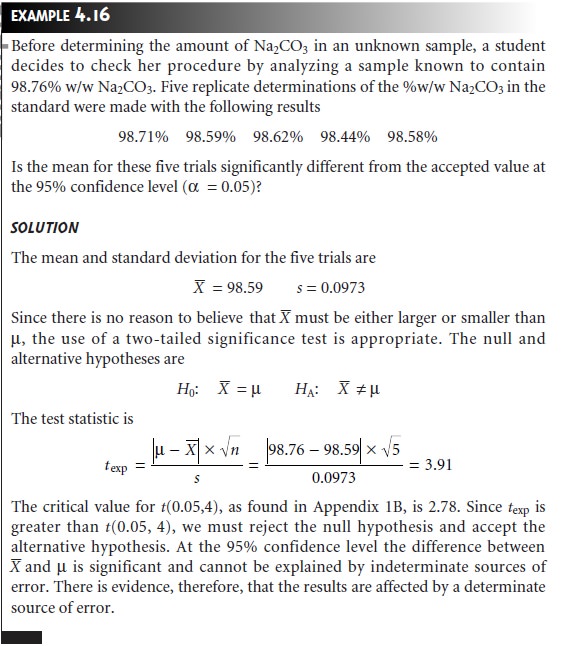
If evidence for a determinate error is found,
as in Example 4.16, its source
should be identified and corrected before analyzing additional samples. Failing to reject the null hypothesis, however, does not imply that the method
is accurate, but only
indicates that there
is insufficient evidence
to prove the method inaccurate at the stated
confidence level.
The utility of the t-test for X– and μ is improved by optimizing the conditions used in determining X–. Examining equation 4.15 shows that increasing the num- ber of replicate determinations, n, or improving the precision of the analysis en- hances the utility of this significance test. A t-test can only give useful results, however, if the standard deviation for the analysis is reasonable. If the standard deviation is substantially larger than the expected standard deviation, σ, the confidence interval around X– will be so large that a significant difference between X– and μ may be difficult to prove. On the other hand, if the standard deviation is significantly smaller than expected, the confidence interval around X will be too small, and a significant difference between X and μ may be found when none ex- ists. A significance test that can be used to evaluate the standard deviation is the subject of the next section.
Comparing s2 to σ2
When a particular type of sample is analyzed
on a regular basis, it may be possible
to determine the expected, or true variance, σ
2, for the
analysis. This often
is the case in clinical labs where hundreds
of blood samples
are analyzed each day. Repli- cate analyses of any
single sample, however, results in a sample variance, s2. A statis-
tical comparison of s2 to σ2 provides useful information about whether the analysis
is in a state of “statistical control.” The null hypothesis is that σ 2 and s2 are identical, and the alternative hypothesis is that they
are not identical.
The test statistic for evaluating the
null hypothesis is called an F-test, and
is given as either

depending on whether
s2 is larger or smaller
than σ2. Note that Fexp is defined such that
its value is always greater
than or equal
to 1.
If the null hypothesis is true, then
Fexp should
equal 1. Due to indeterminate er- rors, however, the value for Fexp usually is greater
than 1. A critical value,
F(α, vnum, vden), gives
the largest value
of F that can be explained by indeterminate error.
It is chosen for a specified significance level, α, and the degrees of freedom for the variances in the numerator, vnum, and denominator, vden. The degrees
of freedom for s2 is
n
– 1, where
n
is the number
of replicates used in determining the sample’s vari- ance. Critical values of F for α = 0.05
are listed in Appendix 1C for both
one-tailed and two-tailed significance tests.
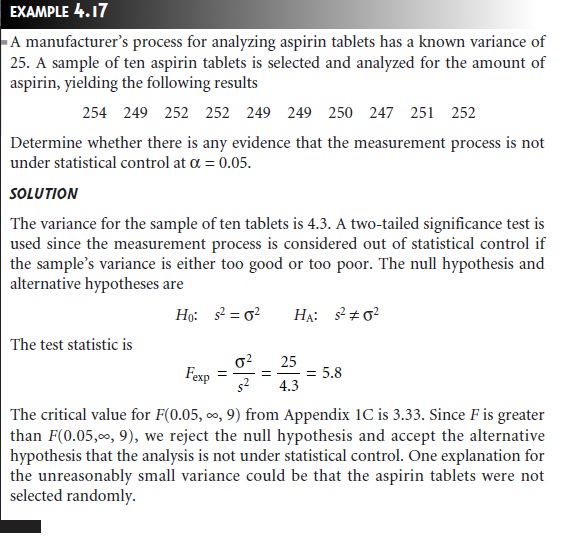
Comparing Two Sample Variances
The F-test
can be extended to the comparison of variances for
two samples, A and
B, by rewriting equation 4.16 as

where A and B are
defined such that s2A
is greater than or equal to s2B. An example of this
application of the F-test is shown in
the following example.
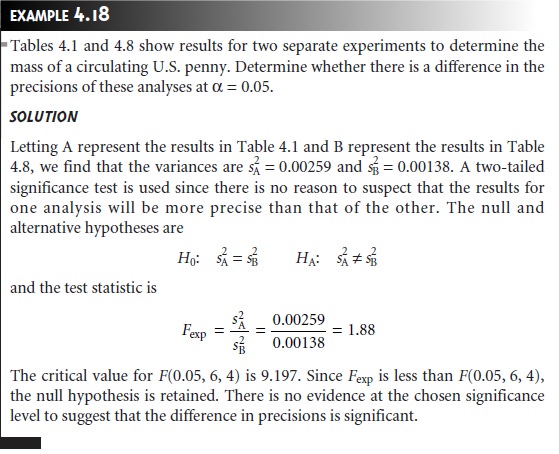
Comparing Two Sample Means
The result of an analysis
is influenced by three factors:
the method, the sample, and the
analyst. The influence of these factors
can be studied
by conducting a pair of ex-
periments in which only one factor is changed. For example, two methods can be
compared by having the same analyst apply both methods
to the same sample and examining the resulting means.
In a similar fashion, it is possible to compare two analysts or two samples.
Significance testing for
comparing two mean
values is divided
into two cate- gories depending on the
source of the
data. Data are
said to be unpaired
when each mean is derived from the analysis
of several samples
drawn from the same source. Paired data are
encountered when analyzing a series of samples drawn
from different sources.
Unpaired Data
Consider two samples, A and B, for which
mean values, X–A, X–B,, and standard deviations, sA and sB, have been measured. Confidence intervals for
μA and μB can be written
for both samples

where nA
and nB are the number of
replicate trials conducted on samples A and B. A comparison of the mean values
is based on the null hypothesis that X–A and X–B are identical,
and an alternative hypothesis that the means are significantly different.
A test statistic is derived by letting μA equal μB,
and combining equations 4.17


The value of texp is compared with
a critical value,
t(α, v), as determined by the cho- sen significance level, α, the degrees
of freedom for the sample,
v, and whether the significance test is one-tailed or two-tailed.
It is unclear,
however, how many degrees of freedom are associated with t(α,
v) since there are
two sets of independent measurements. If the variances sA2 and
sB2 esti- mate the same σ2, then the
two standard deviations can be factored out of equation 4.19 and replaced
by a pooled standard deviation, spool, which
provides a better
esti- mate for the
precision of the
analysis. Thus, equation 4.19 becomes

As indicated by the denominator of equation 4.21,
the degrees of freedom for
the pooled standard deviation is nA + nB – 2.
If sA and sB are significantly different, however, then texp must
be calculated using equation
4.19. In this case, the degrees of freedom is calculated using the fol- lowing imposing equation.

Since the degrees
of freedom must be an integer, the value of v obtained
using equation 4.22 is rounded to the nearest
integer.
Regardless of whether
equation 4.19 or 4.20 is used to calculate texp, the null hy- pothesis is rejected if texp is greater than
t(α, v), and retained if texp is less than
or equal to t(α, v).
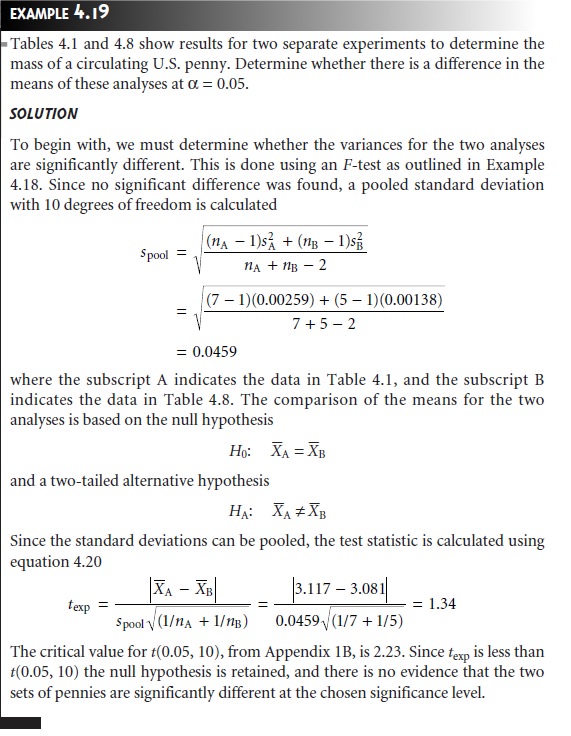
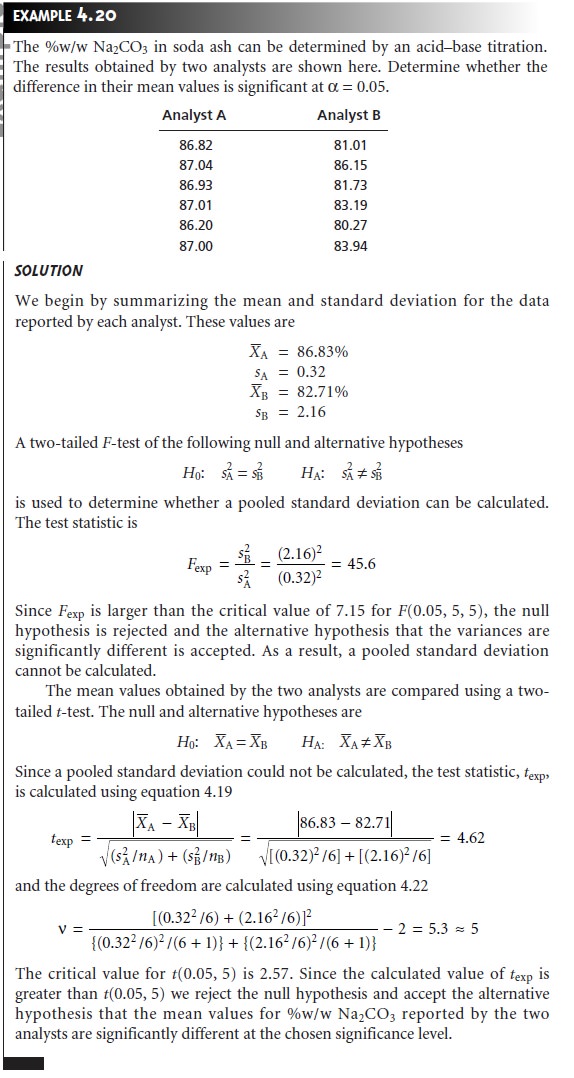
Paired Data
In some situations the variation within
the data sets being compared is more significant than the difference between the means
of the two data sets.
This is commonly encountered in clinical and
environmental studies, where
the data being compared usually consist of a set
of samples drawn
from several populations. For example, a study
designed to investigate two procedures for monitoring the concentration of glucose in blood might involve blood samples drawn from ten pa-
tients. If the variation in the blood
glucose levels among
the patients is significantly
larger than the anticipated variation between the methods, then an analysis in which the data are treated
as unpaired will fail to find a significant difference between the methods. In general, paired
data sets are used whenever
the variation being
investi- gated is smaller
than other potential sources of variation.
|
i |
The test statistic, texp,
is derived from a confidence interval around d–

where n is the number
of paired samples. Replacing t with texp and rearranging gives

The value of texp is then compared with a critical value, t(α,
v), which is determined
by the chosen significance level,
α, the degrees
of freedom for
the sample, v, and
whether the significance test is one-tailed or two-tailed. For
paired data, the
degrees of freedom is n – 1. If texp is greater than
t(α, v), then the null hypothesis is rejected and the alternative hypothesis is accepted. If texp is less than or equal to t(α, v), then
the null hypothesis is retained, and a significant difference has not been demon- strated at the stated
significance level. This
is known as the paired t-test.
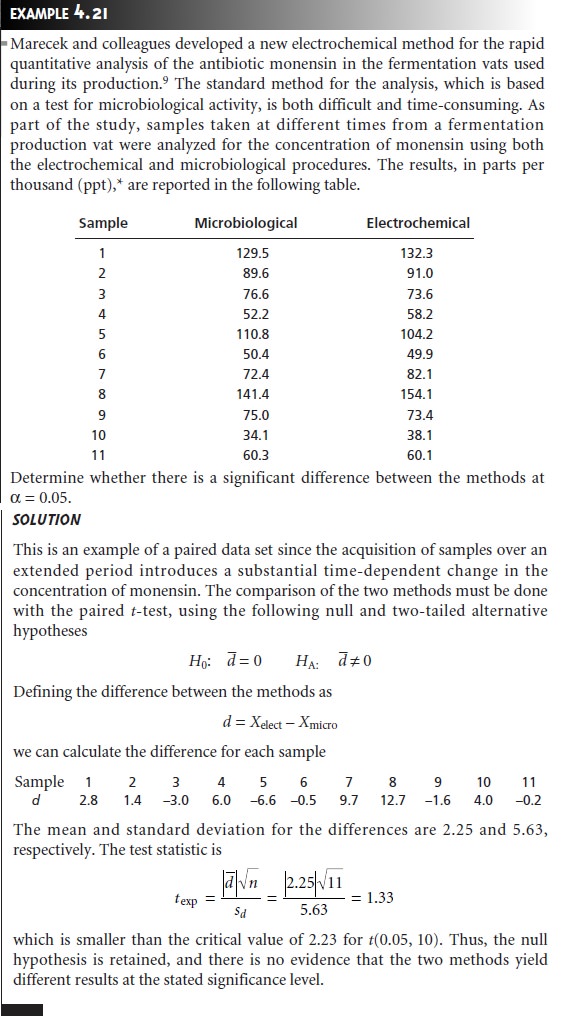
|
i |
Outliers
On occasion, a data set
appears to be skewed by the presence of one or more data points that are not consistent with the remaining data points. Such values are called outliers. The
most commonly used significance test for identifying outliers is Dixon’s
Q-test. The null hypothesis is that the
apparent outlier is taken from
the same popula- tion as the remaining data. The alternative hypothesis is that
the outlier comes
from a different population, and, therefore, should
be excluded from
consideration.
The Q-test
compares the difference between the suspected outlier and its near-
est numerical neighbor to the range
of the entire
data set. Data
are ranked from smallest to largest so that the
suspected outlier is either the
first or the
last data point. The test statistic, Qexp, is calculated using
equation 4.23 if the suspected out- lier is the smallest value (X1)

where n is the number of members in the data set, including the suspected outlier. It is important to note that
equations 4.23 and
4.24 are valid
only for the
detection of a single
outlier. Other forms
of Dixon’s Q-test allow
its extension to the detection of multiple outliers.10 The value of Qexp is compared with a critical
value, Q(α, n), at
a significance level
of α. The Q-test
is usually applied
as the more conservative two- tailed test, even though
the outlier is the smallest or largest value
in the data
set. Values for Q(α, n) can be found in Appendix
1D. If Qexp is greater than Q(α,
n), then the null hypothesis is rejected and the outlier
may be rejected. When Qexp is less
than or equal
to Q(α, n) the suspected outlier must be retained.
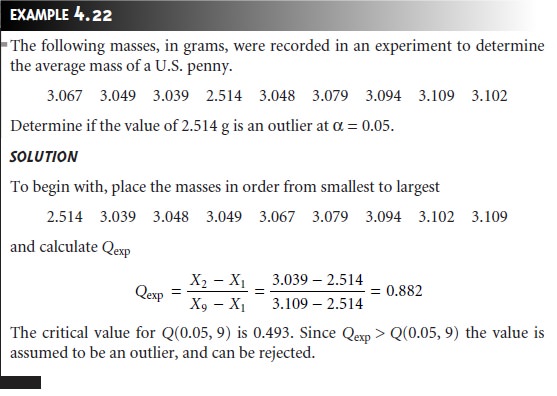
The Q-test should be
applied with caution since there is a probability, equal to α, that an outlier identified by the Q-test actually is not an outlier. In addition, the Q-test should be avoided
when rejecting an outlier leads
to a precision that is un-
reasonably better than the expected
precision determined by a propagation of un- certainty. Given these two concerns it is not surprising that some statisticians cau- tion against the removal of outliers.
On the other hand, testing
for outliers can provide useful information if we try to understand the source of the suspected
out- lier. For example,
the outlier identified in Example 4.22 represents a significant
change in the mass of a penny
(an approximately 17% decrease in mass), due to a change
in the composition of the U.S.
penny. In 1982,
the composition of a U.S. penny was changed from a brass
alloy consisting of 95% w/w Cu and 5% w/w Zn, to a zinc core covered with copper.
The pennies in Example 4.22 were therefore drawn from different populations.
Related Topics